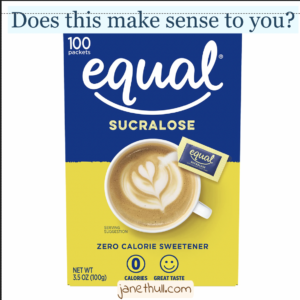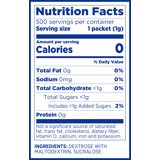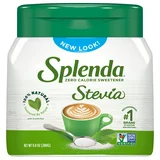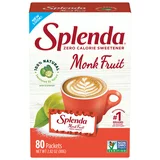
The plethora of chemicals in our food supply just never ends. What do you think of this product?
Equal® and sucralose marketed together? Or is Equal marketing sucralose?
Huh?
When I dug into this, I didn’t find any aspartame in this sweetener, yet it has Equal on the packaging.
Why?
It’s one of two things, in my opinion:
- the 2% rule
- they all own each other – they are marketing their competitor’s sweeteners under their own company brand
Monsanto Chemical Company did this when they bought GD Searle Pharmaceuticals in 1985 – now owning both Sweet ‘N Low® and Nutrasweet/Equal®.
No matter the reason, there is no doubt that the ingredient labeling for the diet sweeteners is getting more and more confusing.
It’s tricky, but I think that’s the goal.
The 2% Rule
According to the State of Louisiana, ingredients that comprise less than 2 percent of a product formula do not need be listed in descending order by predominance of weight or volume.
What this word salad is saying is less than 2% aspartame/Equal may be in this product above, but the manufacturers don’t have to list them if they’re less than 2%.
In opposition to this, according to this FDA website, food manufacturers are required to list all ingredients in the food on the label. They state:
On a product label, the ingredients are listed in order of predominance, with the ingredients used in the greatest amount first, followed in descending order by those in smaller amounts. The label must list the names of any FDA-certified color additives (e.g., FD&C Blue No. 1 or the abbreviated name, Blue 1). But some ingredients can be listed collectively as “flavors,” “spices,” “artificial flavoring,” or in the case of color additives exempt from certification, “artificial colors“, without naming each one. Declaration of an allergenic ingredient in a collective or single color, flavor, or spice could be accomplished by simply naming the allergenic ingredient in the ingredient list.
This still doesn’t tell me where the aspartame is in this sweetener product. Unless it’s merely on the label to confuse you.


Here’s Another One For You
To me, this product on your right is marketed as Splenda® (sucralose) with stevia, but when you read the ingredients, it is sweetened with stevia and erythritol.
Am I missing something because I don’t see sucralose in there anywhere, but I do see mostly erythritol.

Who Owns What Today?
Who is the parent company of Equal today? Apparently Merisant is, a wholly owned subsidiary of MacAndrews & Forbes. Merisant also owns Canderel, PureVia, and Whole Earth Sweetener Company.
Merisant was the original company that patented and brought Splenda to the USA in 2000. Heartland Food Products Group bought the Splenda brand in 2015, and now sells the sweeteners Splenda Stevia Sweetener, Splenda Monk Fruit Sweetener, Splenda Allulose Sweetener, Splenda Liquid Sweeteners, Splenda Coffee Creamers, Splenda Diabetes Care Shakes, Splenda Sweet Teas, and more.
But it appears that there’s no sucralose (Splenda) in these products – just on the label.
Let’s look at Splenda with monk fruit. See what I found at my local grocer …


There’s mostly erythritol in this sweetener with a little monk fruit. And no sucralose as an ingredient – it’s just on the label.
This label confusion is nothing new – in 1985, Monsanto (patent holder for saccharin products) acquired GD Searle and formed The NutraSweet Company (patent holder for aspartame). Then, 15 years later, Merisant (patent holder for Splenda) purchased Monsanto’s sweetener brand NutraSweet/Equal. Fifteen years after that, Heartland Food Products Group bought the Splenda brand (patent holder for sucralose).
Confused? That’s the goal, I think.
If you really want to get into the weeds, check out this government site for Source 101.9 (j) Labeling Exemptions.
Foods That Are Exempt From Labeling Requirements
The following foods are exempt from labeling requirements. There is no registration filing required associated with the food-based exemptions below.
- Raw fruits;
- Vegetables;
- Fish;
- Dietary Supplements (regulated under §101.36);
- Certain egg cartons;
- Infant Formula and foods for children up to 4 yrs of age (modified requirements apply);
- Foods that contain insignificant amounts of all nutrients required to be in a nutrition panel (i.e. coffee beans, tea leaves, spices, flavor extracts, food colors);
- Packaged single-ingredient meat products that are FDA-regulated (i.e. deer, bison, rabbit, quail, wild turkey, ostrich);
- Foods in small packages that have a total surface area of <12 sq inches;
- Foods served or delivered for immediate consumption;
- Food that is served in bulk containers at a retail establishment. The retail establishment must include the ingredients listing on a card or sign, if not on the bulk container itself;
- Foods that are prepared inside a retail establishment and only sold in that establishment (i.e. foods processed and sold onsite by independent delis, bakeries, or salad bars);
- Ingredients that are added to a food for an effect in processing, but are present in the finished product at insignificant levels;
- Some products that are being transported to another facility where they will be processed, packed, or labeled.

So, it appears that the ingredient labeling for the diet sweeteners is getting more and more confusing. Or am I just missing something?
_______________
If you want to learn more about healthy living and disease prevention, contact me at janethull.com. Remember that you are never alone when you are looking for good health!
Join me on my weekly radio/tv show on Healthy Alternatives, and click https://janethull.com/healthyalternatives to get notified when new shows air.
Gain access to all of my online programs, ongoing support, monthly Q&A, and more by joining me on janethull.com. I look forward to supporting you on your journey to alternative health and wellness.
_____________
Disclaimer: This article is for informational purposes only, and is educational in nature. The FDA may not have evaluated some of the statements. This article is not intended to diagnose, treat, cure, or prevent any disease. Please discuss with your own, qualified health care provider before adding supplements or making any changes to your dietary program.
Before taking vitamins, consult your doctor; pre-existing medical conditions or medications you are taking can affect how your body responds to multivitamins.
You have our permission to reprint this article if you attribute us with a live back-link to this article and the youtube links. http://www.janethull.com/
INFORMATION ON THIS WEB SITE IS PROVIDED FOR INFORMATIONAL AND EDUCATIONAL PURPOSES ONLY. THE INFORMATION IS A RESULT OF YEARS OF PRACTICE EXPERIENCE BY THE AUTHOR. THIS INFORMATION IS NOT INTENDED AS A SUBSTITUTE FOR THE ADVICE PROVIDED BY YOUR PHYSICIAN OR OTHER HEALTHCARE PROFESSIONAL OR ANY INFORMATION CONTAINED ON OR IN ANY PRODUCT LABEL OR PACKAGING. DO NOT USE THE INFORMATION ON THIS WEB SITE FOR DIAGNOSING OR TREATING A HEALTH PROBLEM OR DISEASE, OR PRESCRIBING MEDICATION OR OTHER TREATMENT. ALWAYS SPEAK WITH YOUR PHYSICIAN OR OTHER HEALTHCARE PROFESSIONAL BEFORE TAKING ANY MEDICATION OR NUTRITIONAL, HERBAL OR HOMEOPATHIC SUPPLEMENT, OR USING ANY TREATMENT FOR A HEALTH PROBLEM. IF YOU HAVE OR SUSPECT THAT YOU HAVE A MEDICAL PROBLEM, CONTACT YOUR HEALTH CARE PROVIDER IMMEDIATELY. DO NOT DISREGARD PROFESSIONAL MEDICAL ADVICE OR DELAY IN SEEKING PROFESSIONAL ADVICE BECAUSE OF SOMETHING YOU HAVE READ ON THIS WEB SITE. INFORMATION PROVIDED ON THIS WEB SITE AND THE USE OF ANY PRODUCTS OR SERVICES PURCHASED FROM OUR WEB SITE BY YOU DOES NOT CREATE A DOCTOR-PATIENT RELATIONSHIP BETWEEN YOU AND ANY OF THE PHYSICIANS AFFILIATED WITH OUR WEB SITE. INFORMATION AND STATEMENTS REGARDING DIETARY SUPPLEMENTS HAVE NOT BEEN EVALUATED BY THE FOOD AND DRUG ADMINISTRATION AND ARE NOT INTENDED TO DIAGNOSE, TREAT, CURE, OR PREVENT ANY DISEASE AND SERVE ONLY AS EDUCATIONAL
_______________